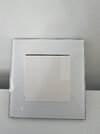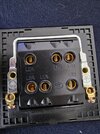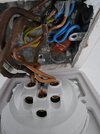Well, as neither of us has ever come across such an item, it cannot be a common practice so - presumably not.Well, I can see a potential commercial 'point', given that the market for intermediate switches is presumably tiny compared with the market for 'two-way' ones. It is presumably simpler/cheaper just to throw two standard 'two-way' modules onto a faceplate and link their rockers that to explicitly manufacture 'intermediate modules', isn't it?
You are using an out of date browser. It may not display this or other websites correctly.
You should upgrade or use an alternative browser.
You should upgrade or use an alternative browser.
intermediate light switch help
- Thread starter Headtotoes
- Start date
As you say, and for whatever reason, it clearly is an extremely uncommon practice.Well, as neither of us has ever come across such an item, it cannot be a common practice so - presumably not.
It does, of course, only work for single-gang intermediates, whereas they could probably get two, maybe three, intermediates on a 'single' faceplate if they had explicitly 'intermediate' modules.
Kind Regards, John
Well presumably it is, or they wouldn't be doing it!Well, as neither of us has ever come across such an item, it cannot be a common practice so - presumably not.
The Trendi switches, for example are a modern switch, designed to be modular from the start.
Economies of scale don't always make obvious sense, take for example, BMW and their heated seats subscription!
Somewhere along the line, the bean counters have calculated that they may save fractions of a penny (probably Chinese Yuan), by doing it this way.
Edit...
Here's my 1 gang 2-way switch.
It would only take a very simple modification to the rocker to switch two modules...
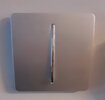
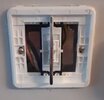
Last edited:
It clearly has not been, and still isn't, a 'common practice' since few, if any, of us have seen anything like this before! As for 'the future, who knows?!Well presumably it is, or they wouldn't be doing it!
Yes, but that is not, in itself, an explanation. Other 'modular' ranges of accessories do include explicit 'intermediate switch' modules.The Trendi switches, for example are a modern switch, designed to be modular from the start.
As I wrote, I can see potential commercial advantage in doing what they have done, since it precludes the need to produce explicit intermediate modules. However, as I also wrote, it limits them to one intermediate per 'single' plate, whereas they could have two, maybe three, if they had intermediate modules.
Kind Regards, John
- Joined
- 15 Feb 2023
- Messages
- 5
- Reaction score
- 2
- Country

Hello again,
As suggested in order to stop all the "bickering" I've taken the photographs of all 3 light switches.
Downstairs - 1 gang 2 way
Upstairs (landing) in-between - 1 gang 2 way, same light switch as downstairs. This is where usually an intermediate switch is located. However, in my case the electricians have put 1 gang 2 way.
Upstairs - 1 gang intermediate a cheap British white switch. This is where usually a 1 gang 2 way is located.

The new intermediate has got 1 gang too. The photograph of both front and back are attached.
Many thanks in advance!
As suggested in order to stop all the "bickering" I've taken the photographs of all 3 light switches.
Downstairs - 1 gang 2 way
Upstairs (landing) in-between - 1 gang 2 way, same light switch as downstairs. This is where usually an intermediate switch is located. However, in my case the electricians have put 1 gang 2 way.
Upstairs - 1 gang intermediate a cheap British white switch. This is where usually a 1 gang 2 way is located.
The new intermediate has got 1 gang too. The photograph of both front and back are attached.
Many thanks in advance!
Attachments
Thank you - so Bernard is right. Live and learn.
Why are the two 1 gang 2 way switches different?
Why are the two 1 gang 2 way switches different?
One is shown upside down so that the screw heads cant be seen?Why are the two 1 gang 2 way switches different?
Well, I don't know about 'bickering' but, maybe because I'm dim, I could not tell you (without seeing some documentation) how one is meant to wire that "new intermediate switch" - since one expects an intermediate switch to have four, not six, terminalsAs suggested in order to stop all the "bickering" I've taken the photographs of all 3 light switches. .... The new intermediate has got 1 gang too. The photograph of both front and back are attached.
Does it come with 'instructions'?
Kind Regards, John
Yes, maybe/probably - but as I've just written, without some 'instructions' I would not know how to wire that new switch, would you?Thank you - so Bernard is right. Live and learn.
Kind Regards, John
Ok, thanks. I did think that might be the case but it really doesn't look like it.One is shown upside down so that the screw heads cant be seen?
- Joined
- 15 Feb 2023
- Messages
- 5
- Reaction score
- 2
- Country

One is shown upside down so that the screw heads cant be seen?
Yes, the one downstairs was wired upside down
Attachments
Bernard showed us - post 42.Yes, maybe/probably - but as I've just written, without some 'instructions' I would not know how to wire that new switch, would you?
I dare say I could have figured it out - as you would for a double pole switch.
Yes he did:Bernard showed us - post 42.
I dare say I could have figured it out - as you would for a double pole switch.
But that switch has the SPDT 'V's line up.
With the OPs switch, one 'V' is inverted - there may need to be a little experimentation needed to determine which contacts are switched at the same time!
They are both on their side as well.But that switch has the SPDT 'V's line up.
With the OPs switch, one 'V' is inverted
The switches are two separate switches. I don't think any experimentation is required.- there may need to be a little experimentation needed to determine which contacts are switched at the same time!
The switches are two separate switches. I don't think any experimentation is required.
...I'm presuming L1A will be switched at the same time as L1B?
DIYnot Local
Staff member
If you need to find a tradesperson to get your job done, please try our local search below, or if you are doing it yourself you can find suppliers local to you.
Select the supplier or trade you require, enter your location to begin your search.
Please select a service and enter a location to continue...
Are you a trade or supplier? You can create your listing free at DIYnot Local

